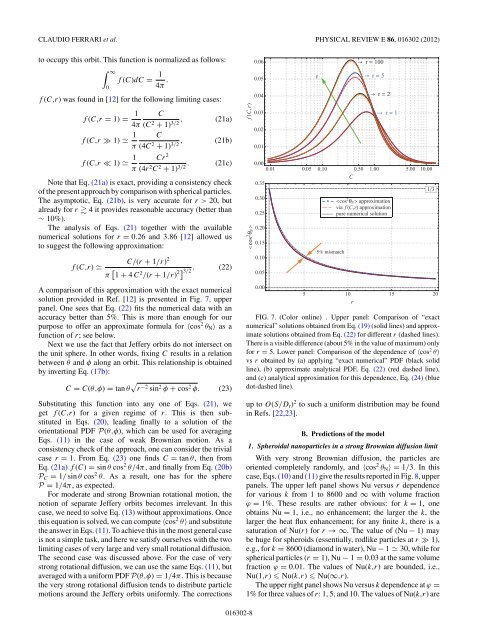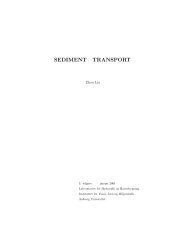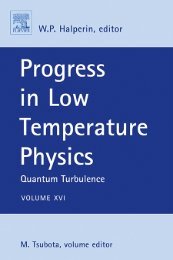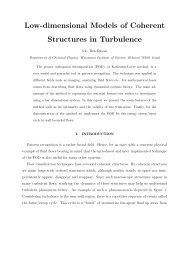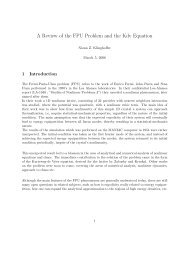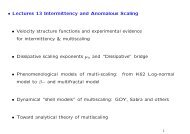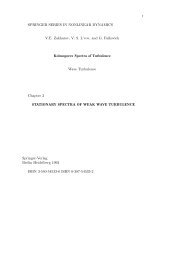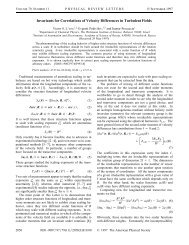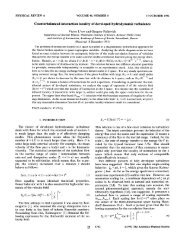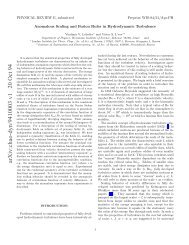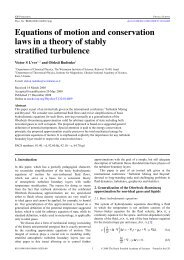Analytical modeling for heat transfer in sheared flows of nanofluids
Analytical modeling for heat transfer in sheared flows of nanofluids
Analytical modeling for heat transfer in sheared flows of nanofluids
Create successful ePaper yourself
Turn your PDF publications into a flip-book with our unique Google optimized e-Paper software.
CLAUDIO FERRARI et al. PHYSICAL REVIEW E 86, 016302 (2012)<br />
to occupy this orbit. This function is normalized as follows:<br />
∞<br />
f (C)dC =<br />
0<br />
1<br />
4π .<br />
f (C,r) was found <strong>in</strong> [12] <strong>for</strong> the follow<strong>in</strong>g limit<strong>in</strong>g cases:<br />
f (C,r = 1) = 1 C<br />
4π (C2 , (21a)<br />
+ 1) 3/2<br />
f (C,r ≫ 1) 1 C<br />
π (4C2 , (21b)<br />
+ 1) 3/2<br />
f (C,r ≪ 1) 1 Cr<br />
π<br />
2<br />
(4r2C 2 . (21c)<br />
+ 1) 3/2<br />
Note that Eq. (21a) is exact, provid<strong>in</strong>g a consistency check<br />
<strong>of</strong> the present approach by comparison with spherical particles.<br />
The asymptotic, Eq. (21b), is very accurate <strong>for</strong> r>20, but<br />
already <strong>for</strong> r 4 it provides reasonable accuracy (better than<br />
∼ 10%).<br />
The analysis <strong>of</strong> Eqs. (21) together with the available<br />
numerical solutions <strong>for</strong> r = 0.26 and 3.86 [12] allowed us<br />
to suggest the follow<strong>in</strong>g approximation:<br />
C/(r + 1/r)<br />
f (C,r) <br />
2<br />
π 1 + 4 C2 /(r + 1/r) 2 . (22)<br />
3/2<br />
A comparison <strong>of</strong> this approximation with the exact numerical<br />
solution provided <strong>in</strong> Ref. [12] is presented <strong>in</strong> Fig. 7, upper<br />
panel. One sees that Eq. (22) fits the numerical data with an<br />
accuracy better than 5%. This is more than enough <strong>for</strong> our<br />
purpose to <strong>of</strong>fer an approximate <strong>for</strong>mula <strong>for</strong> 〈cos2 θN〉 as a<br />
function <strong>of</strong> r; see below.<br />
Next we use the fact that Jeffery orbits do not <strong>in</strong>tersect on<br />
the unit sphere. In other words, fix<strong>in</strong>g C results <strong>in</strong> a relation<br />
between θ and φ along an orbit. This relationship is obta<strong>in</strong>ed<br />
by <strong>in</strong>vert<strong>in</strong>g Eq. (17b):<br />
C = C(θ,φ) = tan θ r −2 s<strong>in</strong> 2 φ + cos 2 φ. (23)<br />
Substitut<strong>in</strong>g this function <strong>in</strong>to any one <strong>of</strong> Eqs. (21), we<br />
get f (C,r) <strong>for</strong> a given regime <strong>of</strong> r. This is then substituted<br />
<strong>in</strong> Eqs. (20), lead<strong>in</strong>g f<strong>in</strong>ally to a solution <strong>of</strong> the<br />
orientational PDF P(θ,φ), which can be used <strong>for</strong> averag<strong>in</strong>g<br />
Eqs. (11) <strong>in</strong> the case <strong>of</strong> weak Brownian motion. As a<br />
consistency check <strong>of</strong> the approach, one can consider the trivial<br />
case r = 1. From Eq. (23) one f<strong>in</strong>ds C = tan θ, then from<br />
Eq. (21a) f (C) = s<strong>in</strong> θ cos 2 θ/4π, and f<strong>in</strong>ally from Eq. (20b)<br />
PC = 1/ s<strong>in</strong> θ cos 2 θ. As a result, one has <strong>for</strong> the sphere<br />
P = 1/4π, as expected.<br />
For moderate and strong Brownian rotational motion, the<br />
notion <strong>of</strong> separate Jeffery orbits becomes irrelevant. In this<br />
case, we need to solve Eq. (13) without approximations. Once<br />
this equation is solved, we can compute 〈cos 2 θ〉 and substitute<br />
the answer <strong>in</strong> Eqs. (11). To achieve this <strong>in</strong> the most general case<br />
is not a simple task, and here we satisfy ourselves with the two<br />
limit<strong>in</strong>g cases <strong>of</strong> very large and very small rotational diffusion.<br />
The second case was discussed above. For the case <strong>of</strong> very<br />
strong rotational diffusion, we can use the same Eqs. (11),but<br />
averaged with a uni<strong>for</strong>m PDF P(θ,φ) = 1/4π. This is because<br />
the very strong rotational diffusion tends to distribute particle<br />
motions around the Jeffery orbits uni<strong>for</strong>mly. The corrections<br />
f C,r<br />
cos 2 θ N<br />
016302-8<br />
0.06<br />
0.05<br />
0.04<br />
0.03<br />
0.02<br />
0.01<br />
r<br />
r 100<br />
r 5<br />
r 2<br />
r 1<br />
0.00<br />
0.01 0.05 0.10 0.50 1.00 5.00 10.00<br />
C<br />
0.35<br />
1 3<br />
0.30<br />
0.25<br />
0.20<br />
0.15<br />
0.10<br />
0.05<br />
0.00<br />
cos 2 θN approximation<br />
—– via f C,r approximation<br />
—— pure numerical solution<br />
5 mismatch<br />
5 10 15 20<br />
r<br />
FIG. 7. (Color onl<strong>in</strong>e) . Upper panel: Comparison <strong>of</strong> “exact<br />
numerical” solutions obta<strong>in</strong>ed from Eq. (19) (solid l<strong>in</strong>es) and approximate<br />
solutions obta<strong>in</strong>ed from Eq. (22) <strong>for</strong> different r (dashed l<strong>in</strong>es).<br />
There is a visible difference (about 5% <strong>in</strong> the value <strong>of</strong> maximum) only<br />
<strong>for</strong> r = 5. Lower panel: Comparison <strong>of</strong> the dependence <strong>of</strong> 〈cos 2 θ〉<br />
vs r obta<strong>in</strong>ed by (a) apply<strong>in</strong>g “exact numerical” PDF (black solid<br />
l<strong>in</strong>e), (b) approximate analytical PDF, Eq. (22) (red dashed l<strong>in</strong>e),<br />
and (c) analytical approximation <strong>for</strong> this dependence, Eq. (24) (blue<br />
dot-dashed l<strong>in</strong>e).<br />
up to O(S/Dr) 2 to such a uni<strong>for</strong>m distribution may be found<br />
<strong>in</strong> Refs. [22,23].<br />
B. Predictions <strong>of</strong> the model<br />
1. Spheroidal nanoparticles <strong>in</strong> a strong Brownian diffusion limit<br />
With very strong Brownian diffusion, the particles are<br />
oriented completely randomly, and 〈cos2 θN〉 =1/3. In this<br />
case, Eqs. (10) and (11) give the results reported <strong>in</strong> Fig. 8, upper<br />
panels. The upper left panel shows Nu versus r dependence<br />
<strong>for</strong> various k from 1 to 8600 and ∞ with volume fraction<br />
ϕ = 1%. These results are rather obvious: <strong>for</strong> k = 1, one<br />
obta<strong>in</strong>s Nu = 1, i.e., no enhancement; the larger the k, the<br />
larger the <strong>heat</strong> flux enhancement; <strong>for</strong> any f<strong>in</strong>ite k, there is a<br />
saturation <strong>of</strong> Nu(r) <strong>for</strong>r→∞.Thevalue<strong>of</strong>(Nu−1) may<br />
be huge <strong>for</strong> spheroids (essentially, rodlike particles at r ≫ 1),<br />
e.g., <strong>for</strong> k = 8600 (diamond <strong>in</strong> water), Nu − 1 30, while <strong>for</strong><br />
spherical particles (r = 1), Nu − 1 = 0.03 at the same volume<br />
fraction ϕ = 0.01. The values <strong>of</strong> Nu(k,r) are bounded, i.e.,<br />
Nu(1,r) Nu(k,r) Nu(∞,r).<br />
The upper right panel shows Nu versus k dependence at ϕ =<br />
1% <strong>for</strong> three values <strong>of</strong> r: 1, 5, and 10. The values <strong>of</strong> Nu(k,r)are


